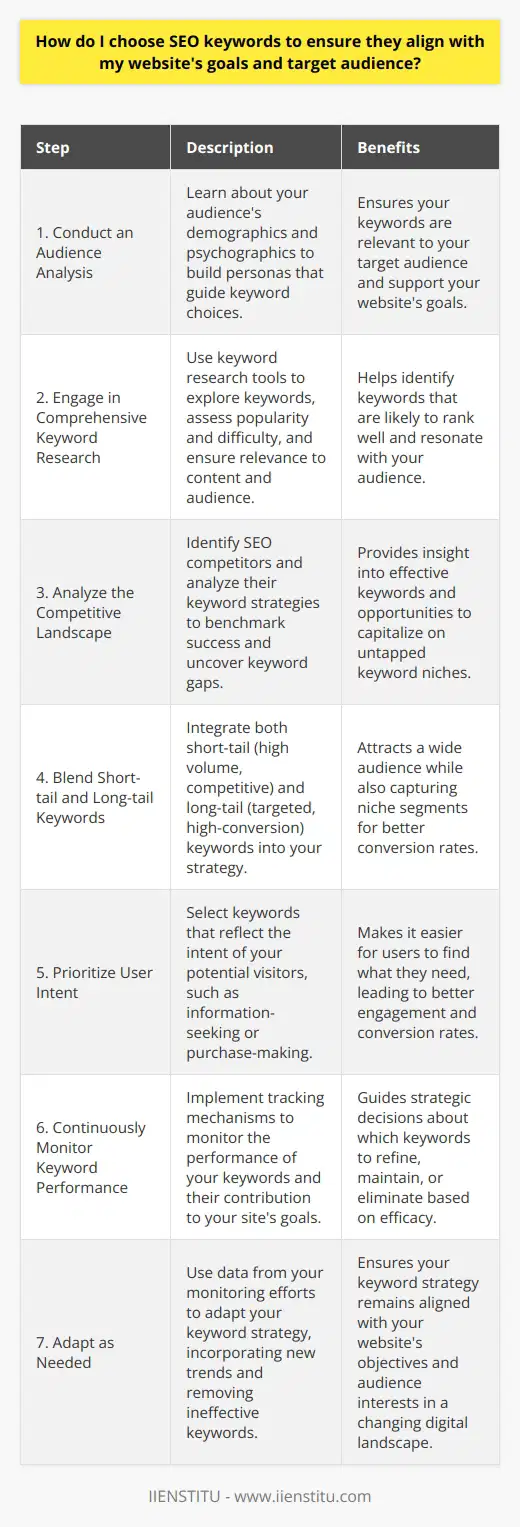
This article discusses the benefits and logistical considerations of conducting a company-wide keyword brainstorm. It explains how a company-wide keyword brainstorm can help ensure that all departments and employees know the importance of keyword research and can contribute their own ideas. It also provides suggestions for gathering keyword suggestions, such as email surveys, breakout sessions, and face-to-face meetings.
Finally, it suggests forming a working group or committee for those particularly motivated to help with keyword research.
Introduction
Benefits of Company-Wide Keyword Brainstorm
Logistical Considerations
Gathering Keyword Suggestions
Conclusion
Introduction: Keyword research is an essential part of any digital marketing strategy. It involves researching and collecting relevant search terms that can be used to target potential customers and drive more traffic to your website. Having a good keyword strategy is essential for any business, but it can be difficult to get everyone involved in the process. This article will discuss the benefits of a company-wide keyword brainstorm and provide some logistical considerations and suggestions for gathering keyword suggestions.
Related Course: Digital Marketing Online Course
Benefits of Company-Wide Keyword Brainstorm
A company-wide keyword brainstorm is an effective way to get everyone involved in the keyword research process. It can help ensure that all departments and employees know the importance of keyword research and can contribute their own ideas. This can also help ensure that all departments and employees are on the same page regarding keyword research and can provide valuable insights into the needs and interests of different departments.
Logistical Considerations
If the business is small enough that it’s logistically possible to call an all-hands meeting to brainstorm for keywords, then this could be an excellent next step. However, for larger businesses, this may not be feasible. Other methods, such as email surveys or breakout sessions, may be more appropriate.
Gathering Keyword Suggestions
Once the logistics of the keyword brainstorming have been determined, the next step is to gather keyword suggestions. This can be done through various methods, including face-to-face meetings, email surveys, and breakout sessions. It’s essential to ensure that everyone has the opportunity to contribute their ideas, as this can help to ensure that all departments and employees are represented.
Conclusion: A company-wide keyword brainstorm can be a great way to get everyone involved in the keyword research process. It can help ensure that all departments and employees know the importance of keyword research and can contribute their own ideas. It is also essential to consider the logistics of the brainstorm and ensure that everyone can contribute their ideas. Finally, it is also essential to consider forming a working group or committee for those particularly motivated to help with keyword research.
A company-wide keyword brainstorm is a key to SEO success for everyone.
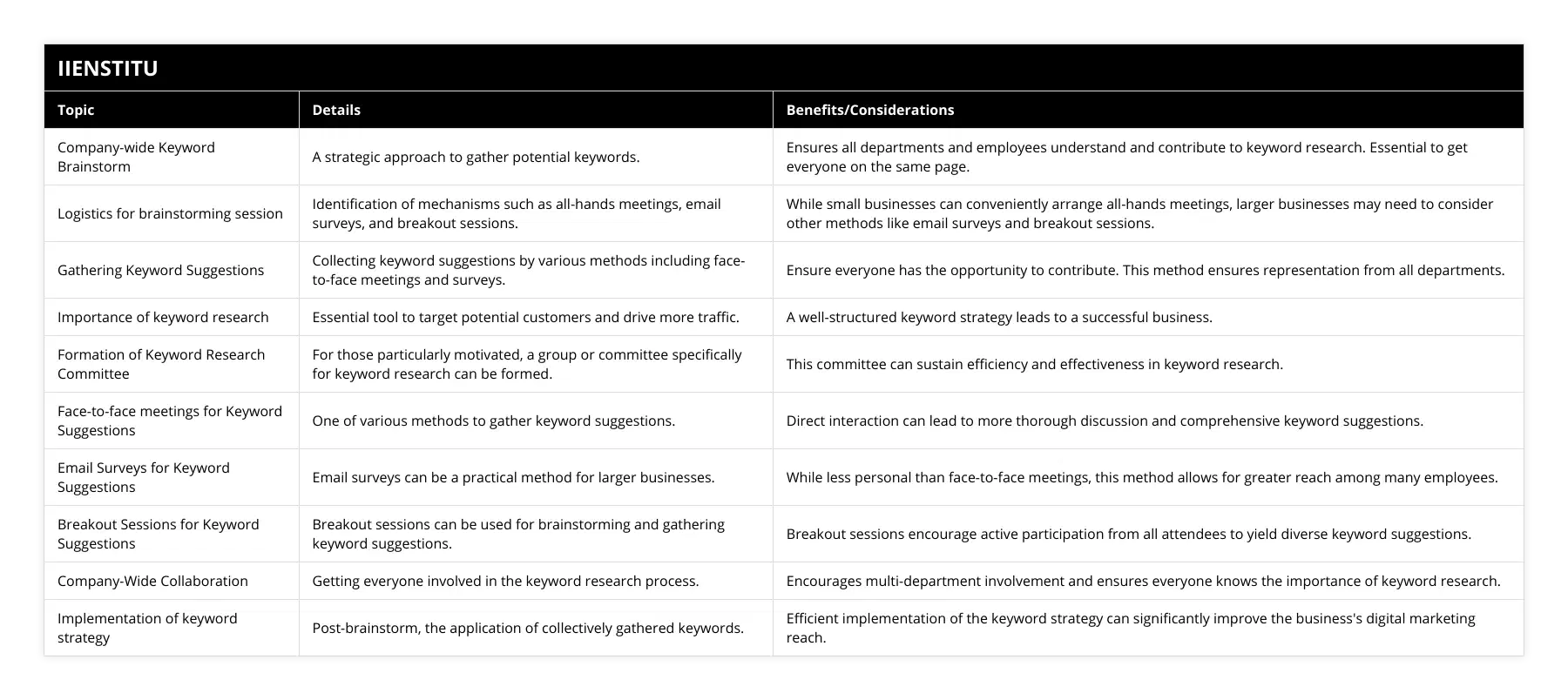
Frequently Asked Questions
What are the benefits of a company-wide keyword brainstorm for SEO?
Using keywords is crucial to any successful Search Engine Optimization (SEO) campaign. A company-wide keyword brainstorm can be a great way to get everyone involved in optimizing a website for search engine visibility. This article will explore the benefits of such brainstorming and discuss how to get the most out of this activity.
The primary benefit of a company-wide keyword brainstorm is that it provides an opportunity for everyone in the organization to contribute to the SEO process. Each individual’s unique perspective can bring fresh ideas and new insights to the process, resulting in more successful SEO campaigns. Additionally, this type of brainstorming allows everyone to become more familiar with SEO concepts and terms, leading to a greater understanding of online marketing.
The second benefit of a company-wide keyword brainstorm is that it can help to identify the most effective keywords for a given website. By pooling the organization's collective knowledge, the most relevant and popular keywords can be identified and incorporated into the website’s content. This will help to ensure that the website’s content is optimized for the most popular search terms, leading to increased visibility and higher rankings in the search engine results.
The third benefit of a company-wide keyword brainstorm is that it can help to identify new opportunities for keyword optimization. By examining the website’s current keyword performance and analyzing the current search engine trends, new keywords can be identified that may provide a competitive edge. This can help ensure the website’s content is continually optimized to take advantage of the latest developments in the search engine landscape.
Finally, a company-wide keyword brainstorm can also help to create a better understanding of the website’s target audience. By examining the keyword performance of the website’s competitors, it can be easier to identify which types of keywords are most effective for a given audience. This can help ensure the website’s content is optimized to appeal to the most relevant audiences.
In conclusion, a company-wide keyword brainstorm can be a great way to get everyone involved in optimizing a website for search engine visibility. By pooling the organization's collective knowledge, the most effective keywords can be identified and incorporated into the website’s content. Additionally, this type of brainstorming can help identify new opportunities for keyword optimization and better understand the website’s target audience. For these reasons, a company-wide keyword brainstorm is essential for any successful SEO campaign.
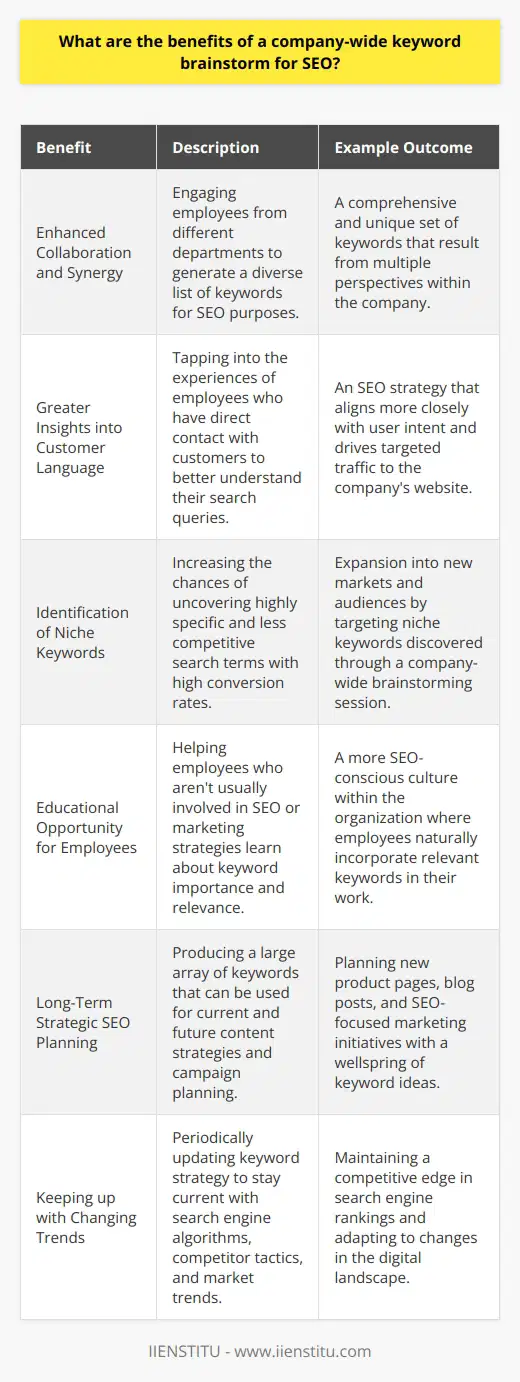
How can we ensure that our keyword brainstorm is effective and efficient?
Keyword brainstorming is an essential part of any effective SEO strategy. It generates and researches potential keywords to target in organic search engine optimization campaigns. However, it can be time-consuming, and it is essential to ensure that the process is both practical and efficient.
The first step in effective keyword brainstorming is identifying the right keywords. To do this, it is essential to consider the needs and interests of your target audience. Start by describing the product or service you are trying to promote and consider what terms a potential customer might use when searching for it. You can also use online tools and analysis to identify relevant keywords and trends. Once you have identified some potential keywords, it is essential to consider the competition. Analyze the competition’s website and the keywords they are targeting to get an idea of what keywords may be more effective for you.
After identifying potential keywords, you should narrow your list by using keyword research tools. Many of these tools will provide keyword search volume and competition-level data, which can help you determine which keywords are the most effective and efficient. These tools can also provide additional keyword ideas you may not have thought of.
Finally, it is essential to test your keywords to ensure they are practical and efficient. Create a test page on your website and use the keywords in the page content and tags. Monitor the performance of this page over time to see which keywords are effective and which should be removed or replaced.
By following these tips, you can ensure that your keyword brainstorming is effective and efficient. However, it is essential to remember that keyword research is an ongoing process, and it is vital to review and update your keyword list regularly to ensure that it is up-to-date and relevant to your target audience.
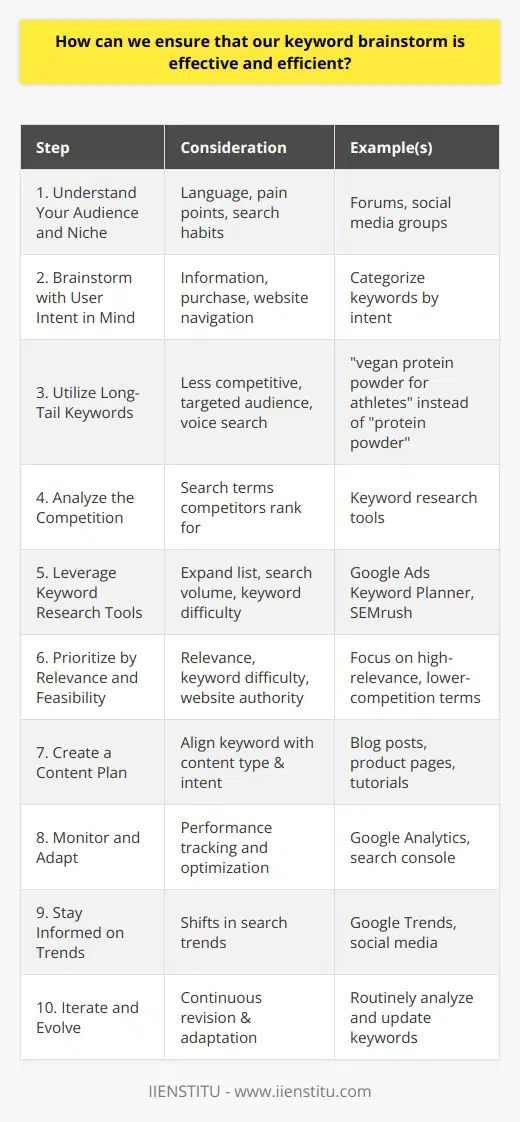
What are the best practices for gathering keyword suggestions for SEO?
Search engine optimization (SEO) makes an online presence more visible on search engine results pages (SERPs) by optimizing the website’s content and structure. To be successful in SEO, it is essential to have keyword research and selection as part of your overall strategy. Keywords are the words and phrases that help search engines understand what a website is about and determine which SERPs to display it in. Gathering keyword suggestions is, therefore a crucial step in optimizing a website for search engine ranking.
Several best practices should be followed when gathering keyword suggestions for SEO. First and foremost, it is essential to thoroughly research the target market and create a list of relevant keywords that reflect the products and services the website offers. This can be done by utilizing keyword suggestion tools, such as Google AdWords Keyword Planner, analyzing competitor websites, and identifying the words and phrases, they target. It is also essential to identify long-tail keywords, which are more specific phrases with lower competition and higher search volumes.
Once the list of relevant keywords has been created, it is essential to analyze their search volumes and competition levels. This can be done by utilizing the same keyword suggestion tools mentioned earlier. It is essential to focus on keywords with a high search volume but not too much competition, as this will make ranking them easier. Additionally, the list of keywords should be updated regularly, as search trends and patterns can change quickly, and it is essential to stay on top of the latest developments.
Finally, it is essential to test the selected keywords and optimize the website. This can be done by conducting A/B tests to determine which keywords are the most effective and making changes accordingly. Additionally, it is essential to track SEO performance and analyze the data to identify the most successful keywords that need to be adjusted.
Following these best practices, website owners can gather practical keyword suggestions and optimize their websites for improved SERP rankings. Doing so will ultimately result in increased website traffic and higher conversions.
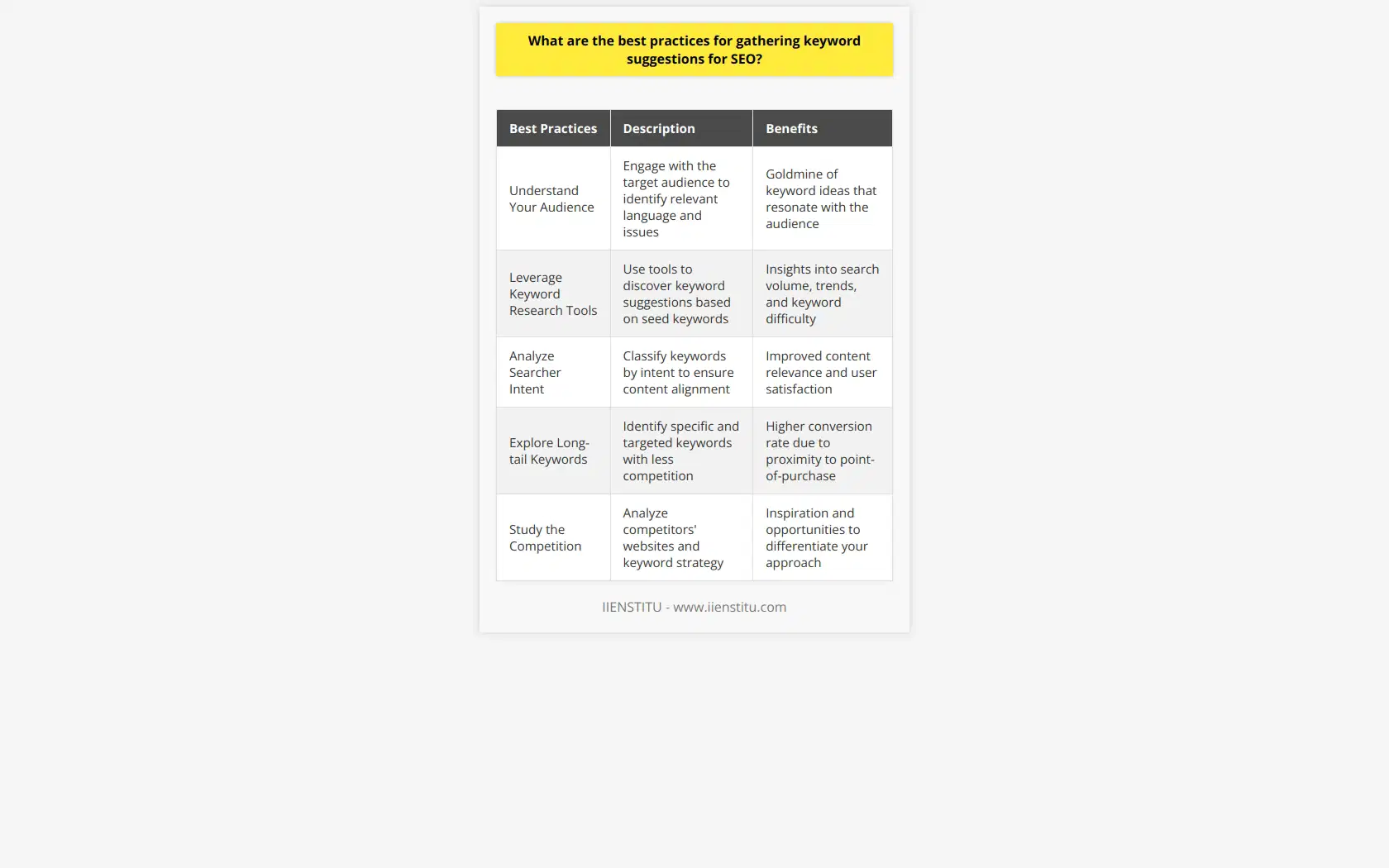
What is the most effective approach to keyword brainstorming for improving SEO rankings?
Comprehensive Keyword Brainstorming Strategies
Understanding User Intent
The most effective approach to keyword brainstorming for improving SEO rankings involves a thorough understanding of user intent, as it is critical in establishing a direct connection between the content and the target audience. User intent refers to the reasons or goals people have when using search engines, which may include informational, transactional, or navigational purposes. By identifying these objectives, content creators can effectively generate relevant keywords that address users' needs and concerns.
Utilizing Keyword Research Tools
Keyword research tools play a significant role in the keyword brainstorming process, as they provide data-driven insights into search trends and volume. One popular tool is Google Keyword Planner, which enables users to analyze search queries and identify high-performing keywords. Other tools, such as SEMrush and Ahrefs, offer more comprehensive features, including competitor analysis and suggestions for both short-tail and long-tail keywords. By leveraging these tools, content creators can obtain a solid foundation for their keyword strategies.
Analyzing Competitor Content
Competitor analysis involves examining and assessing the top-performing content within a specific niche, allowing content creators to understand the strategies employed by successful competitors. By identifying the keywords and topics utilized by these high-ranking websites, one can gain a better understanding of the types of keywords and content structures that appeal to the target audience. Consequently, this information can inform one's keyword brainstorming process and help to create content that resonates with users and ranks well on search engines.
Employing the Inclusion of LSI Keywords
Incorporating latent semantic indexing (LSI) keywords is another crucial aspect of keyword brainstorming for improving SEO rankings. LSI keywords are terms and phrases that are semantically related to the primary keyword, helping search engines understand the content's context and relevance. By including an array of LSI keywords in the content, content creators can enhance their chances of ranking higher on search engines while providing additional information that may be valuable to users.
In conclusion, the most effective approach to keyword brainstorming for improving SEO rankings encompasses a multidimensional strategy that takes into account user intent, keyword research tools, competitor analysis, and the integration of LSI keywords. By considering these factors, content creators can develop a robust keyword strategy that boosts their content's search engine visibility and caters to the needs of the target audience.

How do the 4 types of keywords impact the overall SEO performance of a website?
Impact of Keyword Types on SEO Performance
Types of Keywords
Search engine optimization (SEO) is crucial for increasing the visibility of a website in search engine results. Keywords play a key role in determining the effectiveness of an SEO strategy. The four main types of keywords are generic, broad match, long-tail, and local keywords.
Generic Keywords
Generic keywords are single words or basic phrases with high search volume. They are highly competitive and difficult to rank for in search results, as many websites target these keywords. Despite requiring more effort to attain a high ranking, a strong position for generic keywords brings substantial traffic and visibility for a website.
Broad Match Keywords
Broad match keywords are more specific than generic keywords but still encompass a wide range of search terms. They help websites target users in the early stages of the purchasing funnel, improving click-through rates and conversions. However, broad match keywords may attract irrelevant traffic if not combined with other keyword types to narrow the search context.
Long-tail Keywords
Long-tail keywords are multi-word phrases with lower search volumes, often targeting niche interests. As a result, they are less competitive and easier to rank for than other keyword types. Long-tail keywords cater to users who are closer to making a purchase decision, meaning they often have higher conversion rates. Despite their lower search volume, optimized use of long-tail keywords can significantly improve a website's overall SEO performance.
Local Keywords
Local keywords include geographical references specific to a location, such as a city or region. They are crucial for businesses with a physical presence or targeting a particular area. Incorporating local keywords into website content significantly impacts local search rankings, driving relevant traffic to a business and increasing the likelihood of attracting nearby customers.
Conclusion
The four types of keywords—generic, broad match, long-tail, and local—affect the overall SEO performance of a website in different ways. Each keyword type serves a specific purpose and contributes to a site's visibility, traffic, and conversions. An effective SEO strategy must incorporate a balanced mix of these keywords to maximize the chances of ranking high in search engine results and attracting the desired audience.
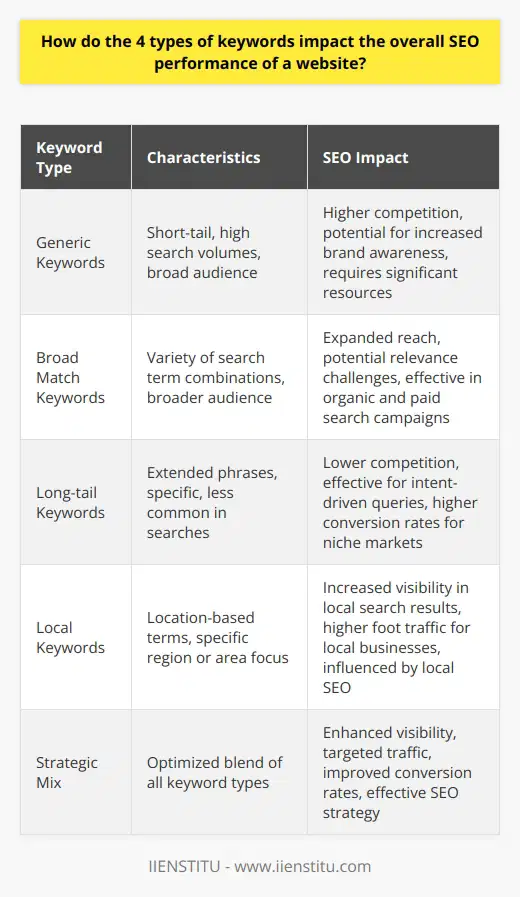
In what ways can conducting an SEO keyword analysis enhance the quality and relevance of a website's content?
Understanding User Intent through Keyword Analysis
Conducting an SEO keyword analysis plays a crucial role in enhancing the quality and relevance of a website's content, particularly for a blog post, by allowing content creators to better understand user intent. This understanding enables authors to bridge the gap between what users search for and the information they present, resulting in content that accurately meets the users' needs.
Attracting Target Audience with Relevant Keywords
Keyword analysis helps in identifying popular search terms and phrases frequently used by the target audience. By incorporating these relevant keywords into the content and metadata of a blog post, the visibility of the website on search engine result pages (SERPs) increases, leading to higher click-through rates and potential engagement from the target audience. This approach ensures that the content remains both useful and relevant to the readers, while simultaneously contributing to the website's prominence and authority within its niche.
Tailoring Content to User Needs
Furthermore, an effective keyword analysis provides insights into the search volumes and competition levels of specific keywords or phrases. A thorough understanding of these factors allows content creators to tailor their blog posts to address common search queries and user pain points. This not only results in content that is better aligned with the user's expectations but also helps build a positive reputation for the website as a reliable source of information.
Encouraging Comprehensive and In-Depth Content
Lastly, keyword analysis can highlight gaps within the existing content, presenting opportunities to create additional comprehensive and in-depth content on various subject matters. This process may involve identifying long-tail keywords – search phrases that are more specific and thus have lower competition levels – and creating blog posts that delve into the nuances and complexities of those subjects. As a result, the finalized content becomes enriched with valuable information, catering to more diverse interests, and further establishing the website as a credible and authoritative destination for users seeking related subject matter.
In conclusion, an SEO keyword analysis offers numerous benefits that enhance the quality and relevance of a website's content, particularly in the context of blog posts. By understanding user intent, attracting the target audience, tailoring content to meet user needs, and encouraging comprehensive and in-depth content, content creators can significantly contribute to the website's overall success through improved visibility and user satisfaction.
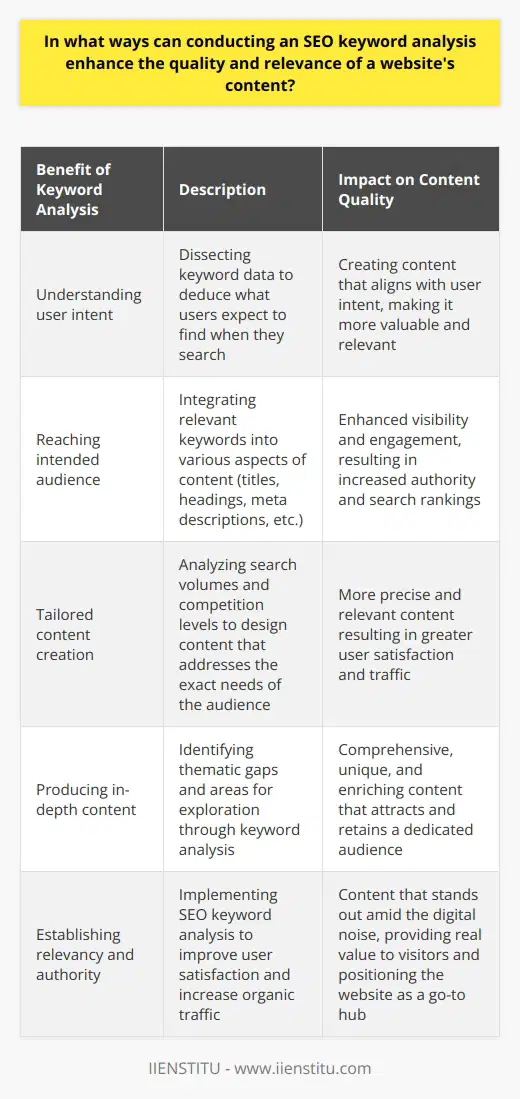
How do you determine the optimal keyword density for SEO purposes?
Determining Optimal Keyword Density
Keyword Selection Criteria
To determine the optimal keyword density for search engine optimization (SEO) purposes, begin by conducting a comprehensive keyword research. This entails understanding your target audience, identifying relevant topics, and analyzing competitor keyword usage. Utilize SEO tools like Google's Keyword Planner, SEMrush, and Moz's Keyword Explorer to assist in this discovery process.
Keyword Context and Relevance
Having identified potential keywords, ensure their context and relevance to the content produced. The keywords must be naturally integrated into the body of the text, creating a seamless reading experience for users. This boosts engagement, leading to higher rankings on search engine results pages (SERPs).
Balancing Keyword Density
Keyword density refers to the ratio of keywords in relation to the total number of words in a given piece of content. Although there is no magic number for optimal keyword density, industry experts suggest targeting a keyword density of 1-2%. Using a keyword density checker can help you verify this balance.
Avoiding Keyword Stuffing
Keyword stuffing occurs when content is saturated with high volumes of keywords, impacting readability and user experience. Major search engines, such as Google, penalize websites engaging in keyword stuffing practices. To ensure a suitable keyword distribution, avoid using the same keyword in consecutive sentences and vary the keyword placement within the content.
LSI Keywords and Synonyms
To enhance SEO performance, incorporate Latent Semantic Indexing (LSI) keywords into the content. LSI keywords are semantically related terms that assist search engines in categorizing and defining content themes. Including synonyms also contributes to the relevance factor, ensuring a broader range of search queries direct traffic to your site.
Readability and User Experience
Focusing on readability and user experience is vital when determining optimal keyword density. Well-structured content featuring headings, subheadings, short paragraphs, and sentences aids users in consuming content effortlessly. Readability analysis tools like Hemingway App or Yoast can provide feedback and improvement suggestions.
In conclusion, determining the optimal keyword density for SEO involves selecting relevant keywords, maintaining a balance between keyword usage and content readability, avoiding keyword stuffing, and incorporating LSI keywords and synonyms. Ultimately, prioritizing user experience while maintaining a proper keyword balance will positively impact a website's SERP rankings.
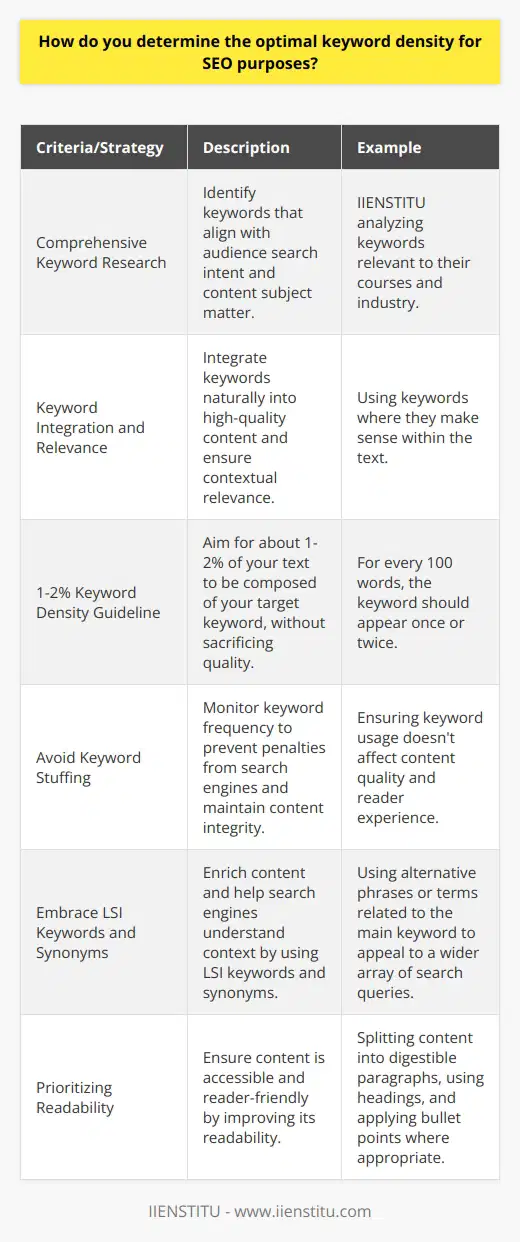
What techniques can be employed to effectively integrate long-tail keywords into content for SEO optimization?
Long-tail Keyword Research
To efficiently integrate long-tail keywords into content for SEO optimization, one must first conduct an extensive keyword research. Utilizing tools such as Google's Keyword Planner, SEMrush, or Ahrefs, one can identify long-tail keywords related to the content's main topic.
LSI and Semantic Keywords
Once the long-tail keywords are identified, it is necessary to incorporate Latent Semantic Indexing (LSI) and semantic keywords into the content. These keywords are related terms or phrases to the primary focus that can bolster relevancy and comprehension for search engines and users.
Strategic Placement of Keywords
After selecting appropriate long-tail, LSI, and semantic keywords, it is crucial to place them strategically throughout the content. Effective insertion of long-tail keywords in headings, sub-headings, title tags, and meta descriptions can result in enhanced search visibility and organic traffic.
Contextual Integration
When incorporating long-tail keywords into the content, avoid keyword stuffing and prioritize contextual integration. This method ensures that keywords are woven seamlessly into the content in a way that resonates with the target audience and retains the content's logical flow.
Frequency of Usage
To avoid redundancy, refrain from using the same long-tail keyword excessively. Although long-tail keywords can boost SEO, overusing them can hinder readability and result in negative SEO consequences. Maintaining a reasonable keyword density throughout the content (around 1-2%) is recommended.
Internal Linking
Another essential technique to integrate long-tail keywords into content is internal linking. This practice involves linking relevant long-tail keyword pages within the site, ultimately creating a more coherent and informative structure. In turn, this can enhance user experience and boost search rankings.
Multimedia Optimization
Lastly, when integrating long-tail keywords into content, consider utilizing multimedia such as images, videos, and audio elements. Including these keywords in alternative text (ALT Tags) or captions will provide additional opportunities for SEO optimization, ensuring the content remains diverse and engaging.
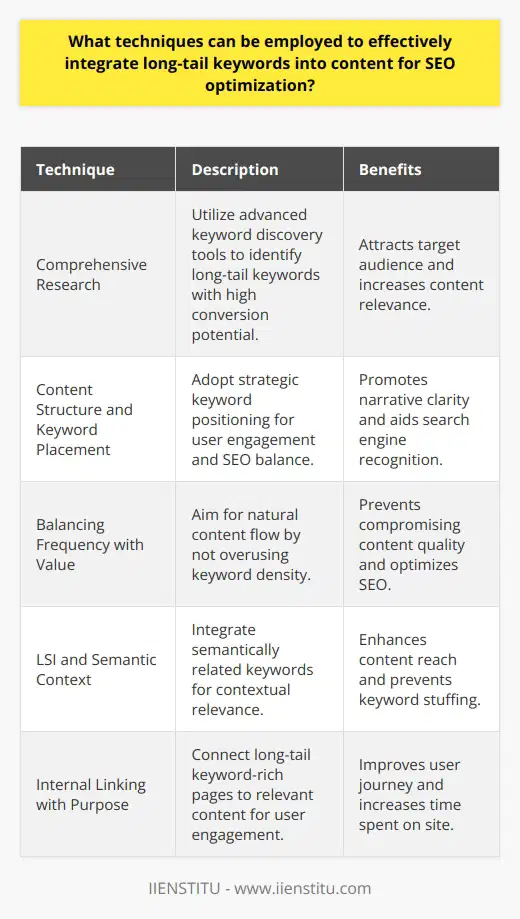
How does the structure and organization of a website influence the success of its SEO keyword strategy?
Impact of Website Structure on SEO Keyword Strategy
The Appropriate Placement
In crafting an effective SEO keyword strategy for a website, the structure and organization play a fundamental role in determining its success. An organized website allows search engine crawlers to efficiently index and rank the site by providing clear pathways for them to follow. Consequently, incorporating target keywords judiciously in essential areas like URLs, title tags, headers, and meta descriptions is imperative to attain high rankings.
Importance of Cohesive Content Grouping
Furthermore, websites that employ a systematic approach in grouping their content into distinct silos or categories enable search engines to understand the content better. By clustering related content under relevant keywords, website owners can improve their site's topical authority on specific subject matters, thereby amplifying the likelihood of ranking higher for target keywords. This approach not only ensures a more user-friendly experience but also enhances the process of internal linking, which is crucial for SEO.
Emphasizing Accessible Navigation
Moreover, a well-structured, easily navigable website allows users and search engines to seamlessly access and understand its content. Websites featuring a hierarchical arrangement with a clear navigation menu enable users to locate desired content with minimal effort, thereby improving dwell time and reducing bounce rates. Both factors contribute significantly to higher search engine rankings, making it essential for websites to prioritize usability and user experience in their design.
Leveraging the Power of Internal Linking
Lastly, the efficacy of an SEO keyword strategy is substantially influenced by the website's internal linking pattern. Proper internal linking ensures that search engine crawlers can effortlessly traverse through the site, helping them identify the most valuable content. Additionally, delivering a well-connected network of internal links serves to distribute link equity among pages, which can bolster both crawlability and the overall authority of the website.
In conclusion, the structure and organization of a website greatly impact the success of its SEO keyword strategy. By focusing on appropriate keyword placement, cohesive content grouping, accessible navigation, and effective internal linking, website owners can significantly enhance their site's search engine performance and improve its visibility to their target audience.
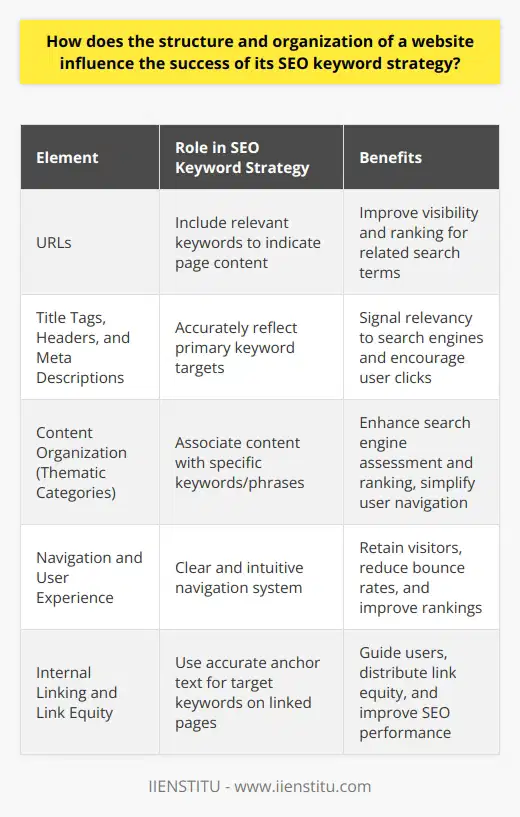
How do you brainstorm keywords for SEO?
Identifying the Target Audience
To brainstorm keywords for SEO (Search Engine Optimization), it is crucial to first identify the intended target audience. Understanding the audience's demographic profile, preferences, and online search behaviors will guide the keyword selection process.
Analyzing Competitors' Strategies
The next step is to analyze the SEO strategies of competitors, specifically their chosen keywords. Examining top-performing competitors sheds light on potential keyword choices and highlights gaps that can be filled through your SEO campaign.
Creating a Seed List of Keywords
Upon understanding the target audience and competitors, you can create a seed list of keywords. These initial keywords are brainstormed based on the primary themes, products, or services covered in the blog post. This list will serve as the foundation for further keyword research.
Utilizing Keyword Research Tools
Utilizing keyword research tools, such as Google Keyword Planner, Moz Keyword Explorer, or SEMrush, allows you to expand the seed list and discover long-tail keywords. These tools provide data on keyword search volume, difficulty, and competition, enabling a more informed decision-making process.
Prioritizing Relevant Keywords
From the generated list of keywords, prioritize the ones most relevant to the blog post's content. Select keywords that match user search intent, as it is essential to deliver content that aligns with what the target audience seeks to find through their online searches.
Considering Synonyms and Variations
As part of the brainstorming process, explore synonyms and variations of the chosen keywords. This step diversifies the keyword pool and increases the odds of ranking highly for multiple search queries.
Organizing Keywords into Logical Groups
Finally, group the chosen keywords into logical sets based on their relevance to different sections of the blog post. Organizing keywords in this manner ensures an efficient, systematic approach to optimizing the content for search engines.
In conclusion, brainstorming keywords for SEO involves understanding the target audience, analyzing competitors, creating a seed list, using keyword research tools, prioritizing relevant keywords, considering synonyms and variations, and organizing them logically. By following these steps, you can create a solid foundation for optimizing your blog post's visibility and ranking on search engine result pages.
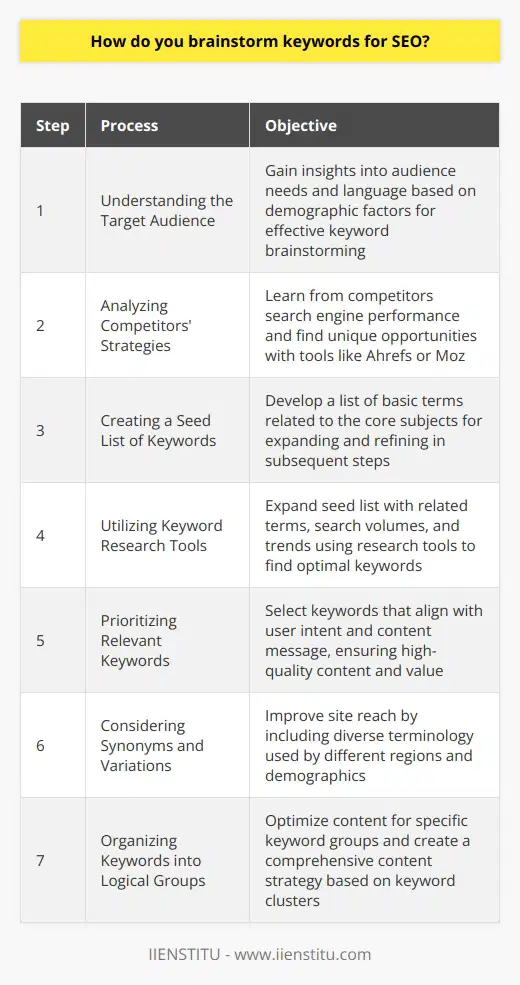
What is the primary objective of SEO keyword strategy, and how does it contribute to the overall success of online content?
Primary Objective of SEO Keyword Strategy
The primary objective of SEO (Search Engine Optimization) keyword strategy is to enhance the visibility of online content by improving its search engine rankings. This is achieved by selecting and incorporating relevant keywords and phrases that potential users may input when searching for information on a topic. By aligning the selected keywords with the online content, search engines can recognize the content as a valuable resource for the users, thereby boosting its rankings in search results.
Improved Organic Traffic
Higher search engine rankings contribute to the overall success of online content by increasing organic traffic – the number of online users who visit the website through non-paid methods. With a robust keyword strategy, blog posts become more accessible to a greater number of users searching for the targeted keywords. Consequently, this increases the likelihood of attracting interested visitors, who may potentially share the content with their network, leading to further organic reach and content engagement.
User Experience Enhancement
Furthermore, a well-executed SEO keyword strategy not only benefits search engine rankings but also enriches the user experience on the website. It ensures that the content is relevant, informative, and aligned with the needs and queries of the target audience. This focus on user satisfaction leads to a more positive experience for visitors, which in turn translates to increased dwell time, low bounce rates, and higher chances of converting casual visitors to loyal followers or customers.
Long-term Sustainability
Adopting a strategic SEO keyword approach also ensures long-term sustainability for the online content. This is because search engines, especially Google, continuously update and refine their algorithms to prioritize high-quality and relevant content. By maintaining up-to-date and audience-centered keyword strategies, blog posts can maintain their search engine ranking and continue to achieve organic traffic, even amidst frequent algorithm updates and increasing online competition.
In conclusion, the primary objective of SEO keyword strategy is to optimize online content for search engine rankings, which fuels its overall success by increasing organic traffic, enhancing user experience, and ensuring long-term sustainability. Ultimately, a comprehensive and well-planned keyword strategy is crucial for any blog post to make a significant impact in the competitive digital landscape.
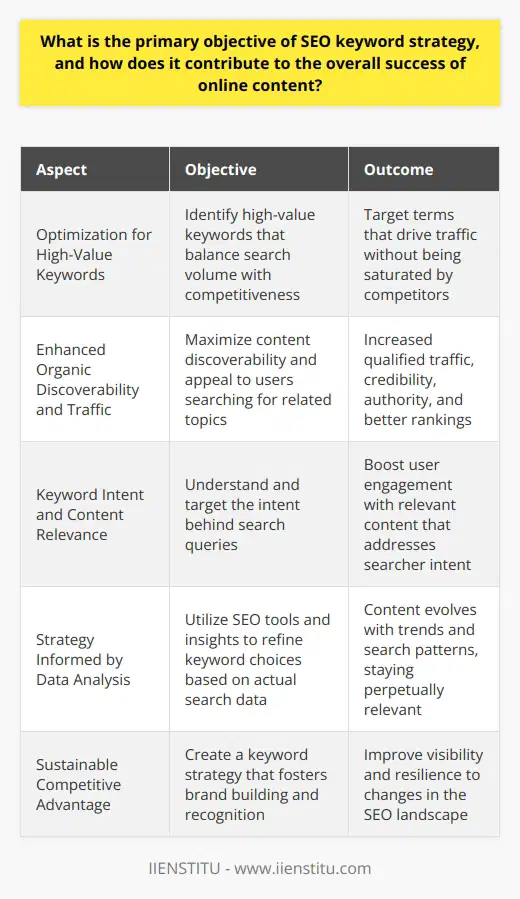
How do I choose SEO keywords to ensure they align with my website's goals and target audience?
Understanding Your Target Audience
To choose SEO keywords that align with your website's goals and target audience, begin by thoroughly understanding your target audience. Analyzing their demographics, psychographics, and online behavior will enable you to identify their needs and preferences concerning content.
Keyword Research and Selection
Conduct comprehensive keyword research using industry-standard tools such as Google Ads Keyword Planner and SEMrush. Analyze the keywords for search volume, competition, and relevance to your website's goals. Select those that are both relevant to your target audience and achievable in terms of ranking.
Analyzing Competitor Keywords
Examine the top-ranking competitors in your niche to understand which keywords they are targeting. This will provide insights into the most effective keywords for your industry and potentially reveal opportunities for your website to target the same or similar keywords.
Balancing Short-tail and Long-tail Keywords
Incorporate a mix of short-tail and long-tail keywords in your SEO strategy. Short-tail keywords, typically composed of one or two words, tend to have higher search volumes but are usually more competitive. Long-tail keywords, with three or more words, offer lower search volumes but are generally less competitive and easier to rank for. Additionally, long-tail keywords often better align with specific user intent, increasing the chances of conversions.
Optimizing for User Intent
Focus on choosing keywords that align with the user intent of your target audience. Keywords should be tailored to the specific information, product, or service your audience is searching for. Reflecting the information users are seeking in your keywords will help attract a more engaged audience and increase the likelihood of conversions.
Regularly Monitoring and Adapting
Continuously monitor the performance of your chosen keywords to ensure they remain effective in achieving your website's goals. Analyze the organic traffic, rankings, and conversions generated by these keywords; if their performance declines, be prepared to adapt your keyword strategy accordingly.
In conclusion, choosing appropriate SEO keywords involves understanding your target audience, researching and selecting relevant keywords, assessing competitor keywords, balancing short-tail and long-tail keywords, optimizing for user intent, and regularly monitoring and adapting your strategy. Following these steps will help ensure your keywords align with your website's goals and target audience, leading to higher organic traffic and increased conversions.
